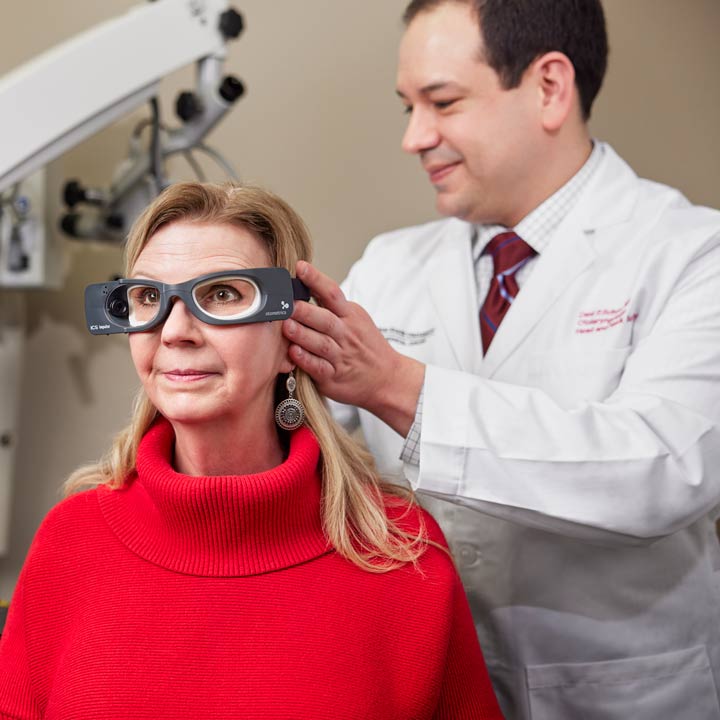 Led by neurotologist Desi Schoo, MD, an interdisciplinary team of specialists across The Ohio State University Wexner Medical Center has been ramping up efforts to formalize a new vestibular center under the direction of the Department of Otolaryngology – Head and Neck Surgery that promises a streamlined pathway to targeted treatments for patients with chronic dizziness and balance issues.
Led by neurotologist Desi Schoo, MD, an interdisciplinary team of specialists across The Ohio State University Wexner Medical Center has been ramping up efforts to formalize a new vestibular center under the direction of the Department of Otolaryngology – Head and Neck Surgery that promises a streamlined pathway to targeted treatments for patients with chronic dizziness and balance issues.
A goal is to eliminate the frustration and lengthy timeline many of these patients have faced by pulling together highly skilled experts focused on care coordination, research and ongoing learning.
“One of the patient populations that is traditionally overlooked, underdiagnosed and mismanaged is patients with chronic dizziness,” says Dr. Schoo, assistant professor in the Division of Otology, Neurotology and Cranial Base Surgery. “We're getting together all the stakeholders who might manage these patients, instead of having patients bounced around before finally, maybe, finding the person who knows what's going on or how to treat them.”
These stakeholders include:
- otolaryngologists
- neurologists, including neurotologists and headache specialists
- vestibular audiologists
- vestibular physical therapists
- rehabilitation psychologists.
Developing a center to address vestibular problems is a unique endeavor, and the hiring of Dr. Schoo in 2023 was a pivotal step toward making it a reality, says Oliver Adunka, MD, division director of Otology, Neurotology and Cranial Base Surgery.
The Ohio State Wexner Medical Center has expertise in all the disciplines necessary to move the needle, Dr. Adunka adds, and putting everyone under one umbrella is critical to the collaboration that best serves this growing patient population.In addition, the department has invested in state-of-the-art equipment including a Visual Eyes 525 Videonystagmography caloric system, an Interacoustics Eclipse EP25 ASSR/VEMP system, and a Virtualis MotionVR+ system to enhance diagnostics across many vestibular disorders.
He notes that dizziness is the most common reason patients give for calling the hospital appointment line, but as many as 30% of people with dizziness visit numerous providers without getting a diagnosis.
“A ton of patients out there are just not being served,” Dr. Adunka says. “It's difficult for these patients to navigate the kind of landscape that they're faced with. This is an effort to provide a better process.”
Saul Strieb, AuD, audiologist and vestibular laboratory coordinator, says the center also will allow partners to serve more patients, access the latest technology and ensure all members of a patient’s care team are able to follow treatment developments.
He says the interdisciplinary approach already is successfully practiced by a panel that takes on the most challenging cases.
“It's about effective identification of what the patient has and then what's the best management,” Strieb says. “It’s all very holistic and should lead to good diagnosis and care.”
Treatment can differ significantly depending on the cause of vestibular problems, and many conditions can be addressed fairly quickly if there’s an understanding of that cause, says Matthew Bjelac, DPT, PT, NCS, a physical therapist who works with patients with vestibular disorders.
“Putting the patient at the center of their condition and having everyone on the medical team on the same page is going to achieve a faster, more ideal outcome,” Bjelac says. “It’s being able to really collaborate, bounce ideas off each other, learn in real time. That doesn't happen a lot in medicine.”
Vestibular therapists are available to patients at multiple ambulatory centers across central Ohio, an asset that will further help make the vestibular center successful.
Vestibular rehabilitation was initiated at the university medical center in 1999 when Greg Wenger, PT, DPT, OCS (currently a physical therapist at The Ohio State University Wexner Medical Center Martha Morehouse Pavilion), received his first referral for dizziness and began pursuing further continuing education for this diagnosis. This development marked the beginning of a strong collaboration with neurotologists, according to Sara Rismiller, PT, MPT, rehab services manager for Neurologic Rehabilitation at Outpatient Care New Albany.
“The Ohio State tripartite mission of clinical care, education and research really lends itself to this type of care,” Rismiller says. “And the structure of Ohio State that allows us opportunities to pursue interdepartmental relationships and to be involved with clinical research has been key for this program's growth.”
Dr. Schoo says the Ohio State Wexner Medical Center also has the vast support and infrastructure needed to make such a venture possible.
“The departmental and faculty support for this type of research was just overwhelming,” he says. “Clinically, it’s very apparent to me that we have a lot of pieces to the puzzle that are missing or not as well organized elsewhere. And the size of our institution allows us to reach and treat and help people.”
